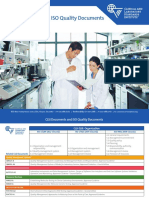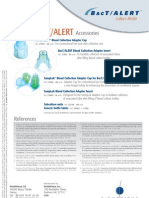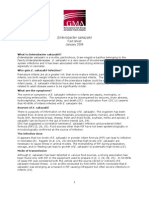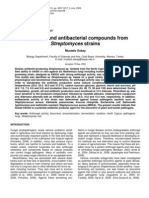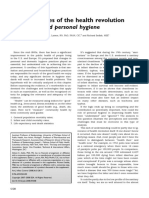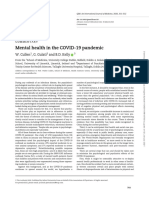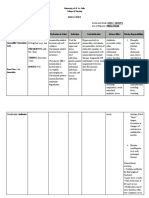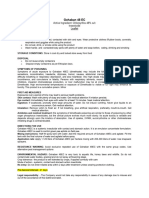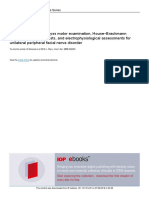Antimicrobial Susceptibility Testing: January 2019
Antimicrobial Susceptibility Testing: January 2019
Uploaded by
Trọng TínCopyright:
Available Formats
Antimicrobial Susceptibility Testing: January 2019
Antimicrobial Susceptibility Testing: January 2019
Uploaded by
Trọng TínOriginal Title
Copyright
Available Formats
Share this document
Did you find this document useful?
Is this content inappropriate?
Copyright:
Available Formats
Antimicrobial Susceptibility Testing: January 2019
Antimicrobial Susceptibility Testing: January 2019
Uploaded by
Trọng TínCopyright:
Available Formats
Antimicrobial susceptibility testing
EUCAST disk diffusion method
Version 7.0
January 2019
EUCAST Disk Diffusion Method for Antimicrobial Susceptibility Testing 1
- Version 7.0 (January 2019)
www.eucast.org
Contents Page
Changes from previous version
Abbreviations and Terminology
1 Introduction 5
2 Preparation and storage of media 6
3 Preparation of inoculum 8
4 Inoculation of agar plates 10
5 Application of antimicrobial disks 11
6 Incubation of plates 12
7 Examination of plates after incubation 14
8 Measurement of zones and interpretation of susceptibility 15
9 Quality control 17
Appendix A 20
EUCAST Disk Diffusion Method for Antimicrobial Susceptibility Testing 2
- Version 7.0 (January 2019)
www.eucast.org
Changes from previous version (v. 6.0)
Section Change
Table 1, Table 3,
New taxonomy: Enterobacteriaceae changed to Enterobacterales.
8.9.3
Table 1, Table 3 Aeromonas spp. added
Instructions for reading of trimethoprim-sulfamethoxazole for
8.9.2
Aeromonas spp. added.
EUCAST Disk Diffusion Method for Antimicrobial Susceptibility Testing 3
- Version 7.0 (January 2019)
www.eucast.org
Abbreviations and terminology
ATCC American Type Culture Collection
http://www.atcc.org
CCUG Culture Collection University of Gothenburg
http://www.ccug.se
CECT Colección Española de Cultivos Tipo
http://www.cect.org
CFU Colony Forming Unit
CIP Collection de l`Institut Pasteur
https://www.pasteur.fr/en/public-health/crbip/collections/collection-institut-
pasteur-cip NEW ADDRESS
DSM Bacterial cultures from Deutsche Sammlung von Mikroorganismen und
Zellkulturen (DSMZ) have DSM numbers
https://www.dsmz.de
ESBL Extended-Spectrum β-Lactamase
EUCAST European Committee on Antimicrobial Susceptibility Testing
http://www.eucast.org
MH Mueller-Hinton agar
MH-F Mueller-Hinton agar for Fastidious organisms (MH supplemented with 5%
defibrinated horse blood and 20 mg/L β-NAD)
MIC Minimum Inhibitory Concentration
MRSA Methicillin Resistant Staphylococcus aureus (with mecA or mecC gene)
NCTC National Collection of Type Cultures
https://www.phe-culturecollections.org.uk/collections/nctc NEW ADDRESS
ß-NAD ß-Nicotinamide Adenine Dinucleotide
QC Quality Control
Saline A 0.85% solution of NaCl in water (8.5 g/L)
EUCAST Disk Diffusion Method for Antimicrobial Susceptibility Testing 4
- Version 7.0 (January 2019)
www.eucast.org
1 Introduction
Disk diffusion is one of the oldest approaches to antimicrobial susceptibility testing
and remains one of the most widely used antimicrobial susceptibility testing
methods in routine clinical laboratories. It is suitable for testing the majority of
bacterial pathogens, including the more common fastidious bacteria, is versatile in
the range of antimicrobial agents that can be tested and requires no special
equipment.
In common with several other disk diffusion techniques, the EUCAST method is a
standardised method based on the principles defined in the report of the
International Collaborative Study of Antimicrobial Susceptibility Testing, 1972, and
the experience of expert groups worldwide.
The zone diameter breakpoints in the EUCAST disk diffusion method are calibrated
to the harmonised European MIC breakpoints that are published by EUCAST and
are freely available from the EUCAST website (http://www.eucast.org).
As with all standardised methods, the described technique must be followed without
modification in order to produce reliable results.
EUCAST Disk Diffusion Method for Antimicrobial Susceptibility Testing 5
- Version 7.0 (January 2019)
www.eucast.org
2 Preparation and storage of media
2.1 Prepare Mueller-Hinton (MH) agar according to the manufacturer’s instructions, with
supplementation for fastidious organisms as indicated in Table 1. Preparation and
addition of supplements are described in detail at http://www.eucast.org.
2.2 The medium should have a level depth of 4.0 0.5 mm (approximately 25 mL in a 90
mm circular plate, 31 mL in a 100 mm circular plate, 71 mL in a 150 mm circular
plate, 40 mL in a 100 mm square plate). Ascertain that a correct volume, based on
the true dimensions of the Petri dish in use, is calculated. Plate dimensions may
differ between manufacturers.
2.3 The surface of the agar should be dry before use. No drops of water should be
visible on the surface of the agar or inside the lid. If necessary, dry plates either at
20-25°C overnight, or at 35°C, with the lid removed, for 15 min. Do not over-dry
plates.
2.4 Store plates prepared in-house at 4-8°C.
2.5 For plates prepared in-house, plate drying, storage conditions and shelf life should
be determined as part of the laboratory quality assurance programme.
2.6 Commercially prepared plates should be stored as recommended by the
manufacturer and used within the labelled expiry date.
2.7 For agar plates (commercially or in-house prepared) stored in plastic bags or sealed
containers, it may be necessary to dry the plates prior to use (see section 2.3). This
is to avoid excess moisture, which may result in problems with fuzzy zone edges
and/or haze within zones.
EUCAST Disk Diffusion Method for Antimicrobial Susceptibility Testing 6
- Version 7.0 (January 2019)
www.eucast.org
Table 1 Media for antimicrobial susceptibility testing
Organism Medium
Enterobacterales MH agar
Pseudomonas spp. MH agar
Stenotrophomonas maltophilia MH agar
Acinetobacter spp. MH agar
Staphylococcus spp. MH agar
Enterococcus spp. MH agar
1
Streptococcus groups A, B, C and G MH-F agar
1
Streptococcus pneumoniae MH-F agar
1
Viridans group streptococci MH-F agar
1
Haemophilus influenzae MH-F agar
1
Moraxella catarrhalis MH-F agar
1
Listeria monocytogenes MH-F agar
1
Pasteurella multocida MH-F agar
1
Campylobacter jejuni and coli MH-F agar (see Appendix A)
1
Corynebacterium spp. MH-F agar
1
Aerococcus sanguinicola and urinae MH-F agar
1
Kingella kingae MH-F agar
Aeromonas spp. MH agar
Other fastidious organisms Pending
1
MH + 5% mechanically defibrinated horse blood + 20 mg/L β-NAD
EUCAST Disk Diffusion Method for Antimicrobial Susceptibility Testing 7
- Version 7.0 (January 2019)
www.eucast.org
3 Preparation of inoculum
3.1 Use the direct colony suspension method to make a suspension of the organism in
saline to the density of a 0.5 McFarland turbidity standard (Table 2), approximately
corresponding to 1-2 x 108 CFU/mL for Escherichia coli.
The direct colony suspension method is appropriate for all organisms, including
fastidious organisms in Table 1.
3.2 Use a sterile loop or a cotton swab to pick colonies from an overnight culture on non-
selective media. Use several morphologically similar colonies (when possible) to
avoid selecting an atypical variant. Suspend the colonies in saline and mix to an
even turbidity.
3.3 Adjust the density of the organism suspension to 0.5 McFarland by adding saline or
more bacteria. A denser inoculum will result in reduced zones of inhibition and a
decreased inoculum will have the opposite effect.
3.3.1 It is recommended that a photometric device is used to adjust the density of
the suspension. The photometric device must be calibrated against a 0.5
McFarland standard according to the manufacturer’s instruction.
3.3.2 Alternatively, the density of the suspension can be compared visually to a
0.5 McFarland turbidity standard. To aid comparison, compare the test and
standard against a white background with black lines.
3.3.3 Streptococcus pneumoniae is, preferably, suspended from a blood agar
plate to the density of a 0.5 McFarland standard. When Streptococcus
pneumoniae is suspended from a chocolate agar plate, the inoculum must
be equivalent to a 1.0 McFarland standard.
3.4 The suspension should optimally be used within 15 min1 and always within 60 min of
preparation.
1
Part of the 15-15-15 minute rule: use the inoculum suspension within 15 minutes of preparation,
apply disks within 15 minutes of inoculation and incubate plates within 15 minutes of disk application.
EUCAST Disk Diffusion Method for Antimicrobial Susceptibility Testing 8
- Version 7.0 (January 2019)
www.eucast.org
Table 2 Preparation of 0.5 McFarland turbidity standard
1 Add 0.5 mL of 0.048 mol/L BaCl2 (1.175% w/v BaCl2·2H20) to 99.5 mL of 0.18
mol/L (0.36 N) H2S04 (1% v/v) and mix thoroughly.
2 Check the density of the suspension in a spectrophotometer with a 1 cm light
path and matched cuvettes. The absorbance at 625 nm should be in the range
0.08 to 0.13.
3 Distribute the suspension into tubes of the same size as those used for
bacterial inoculum suspensions. Seal the tubes.
4 Store sealed standards in the dark at room temperature.
5 Mix the standard thoroughly on a vortex mixer immediately before use.
6 Renew standards or check their absorbance after storage for 6 months.
EUCAST Disk Diffusion Method for Antimicrobial Susceptibility Testing 9
- Version 7.0 (January 2019)
www.eucast.org
4 Inoculation of agar plates
4.1 Make sure that agar plates are at room temperature prior to inoculation.
4.2 Optimally, use the adjusted inoculum suspension within 15 min1 of preparation.
The suspension must always be used within 60 min of preparation.
4.3 Dip a sterile cotton swab into the suspension.
4.3.1 To avoid over-inoculation of Gram-negative bacteria, remove excess
fluid by pressing and turning the swab against the inside of the tube.
4.3.2 For Gram-positive bacteria, do not press or turn the swab against the
inside of the tube.
4.4 When inoculating several agar plates with the same inoculum suspension,
repeat the procedure in section 4.3 for each agar plate.
4.5 Plates can be inoculated either by swabbing in three directions or by using an
automatic plate rotator. Spread the inoculum evenly over the entire agar surface
ensuring that there are no gaps between streaks.
4.5.1 For Gram-positive bacteria, take particular care to ensure that there are
no gaps between streaks.
4.6 Apply disks within 15 min1 of inoculation.
If inoculated plates are left at room temperature for prolonged periods of time
before the disks are applied, the organism may begin to grow, resulting in
erroneous reduction in sizes of inhibition zone diameters.
1
Part of the 15-15-15 minute rule: use the inoculum suspension within 15 minutes of preparation,
apply disks within 15 minutes of inoculation and incubate plates within 15 minutes of disk application.
EUCAST Disk Diffusion Method for Antimicrobial Susceptibility Testing 10
- Version 7.0 (January 2019)
www.eucast.org
5 Application of antimicrobial disks
5.1 The required disk contents are listed in the Breakpoint and Quality Control Tables at
http://www.eucast.org.
5.2 Allow disks to reach room temperature before opening cartridges or containers used
for disk storage. This is to prevent condensation, leading to rapid deterioration of
some agents.
5.3 Apply disks firmly to the surface of the inoculated agar plate within 15 minutes of
inoculation1. Disks must be in close and even contact with the agar surface and must
not be moved once they have been applied as the initial diffusion of antimicrobial
agents from disks is very rapid.
5.4 The number of disks on a plate should be limited to avoid overlapping of zones and
interference between agents. It is important that zone diameters can be reliably
measured. The maximum number of disks depends on the organism and the
selection of disks. Normally 6 and 12 disks are the maximum possible number on a
90 and 150 mm circular plate, respectively.
5.4.1 To be able to detect inducible clindamycin resistance in staphylococci and
streptococci, the erythromycin and clindamycin disks must be placed at a
distance of 12-20 mm from edge to edge for staphylococci and 12-16 mm
from edge to edge for streptococci.
5.5 Loss of potency of antimicrobial agents in disks results in reduced inhibition zone
diameters and is a common source of error. The following are essential:
5.5.1 Store disks, including those in dispensers, in sealed containers with a
moisture-indicating desiccant and protected from light (some agents,
including metronidazole, chloramphenicol and the fluoroquinolones, are
inactivated by prolonged exposure to light).
5.5.2 Store disk stocks according the manufacturers’ instructions. Some agents are
more labile than others (e.g. amoxicillin-clavulanic acid, cefaclor and
carbapenems) and specific recommendations may be available from the
manufacturers.
5.5.3 Store working supplies of disks according to the manufacturers’ instructions.
Once disk containers have been opened, disks should be used within the
time limit specified by the manufacturer.
5.5.4 Discard disks on the manufacturer’s expiry date shown on the container.
5.5.5 Perform frequent quality control (see Section 9) of working supplies to control
that the antimicrobial disks have not lost potency during storage.
1
Part of the 15-15-15 minute rule: use the inoculum suspension within 15 minutes of preparation,
apply disks within 15 minutes of inoculation and incubate plates within 15 minutes of disk application.
EUCAST Disk Diffusion Method for Antimicrobial Susceptibility Testing 11
- Version 7.0 (January 2019)
www.eucast.org
6 Incubation of plates
6.1 Invert agar plates and make sure disks do not fall off the agar surface. Incubate
plates within 15 min1 of disk application. If the plates are left at room temperature
after disks have been applied, pre-diffusion may result in erroneously large zones of
inhibition.
6.2 Stacking plates in the incubator may affect results due to uneven heating. The
efficiency of incubators varies and therefore the control of incubation, including
appropriate number of plates in any one stack, should be determined as part of the
laboratory’s quality assurance programme. For most incubators, a maximum of five
plates per stack is appropriate.
6.3 Incubate plates in the conditions shown in Table 3.
6.3.1 Incubation beyond the recommended time limits should not be performed as
this may result in growth within inhibition zones and reporting isolates as false
resistant.
6.3.2 With glycopeptide susceptibility tests on Enterococcus spp. resistant colonies
may not be visible until plates have been incubated for 24 h. However, plates
may be examined after 16-20 h and any resistance reported, but plates of
isolates appearing susceptible must be re-incubated and reread at 24 h.
1
Part of the 15-15-15 minute rule: use the inoculum suspension within 15 minutes of preparation,
apply disks within 15 minutes of inoculation and incubate plates within 15 minutes of disk application.
EUCAST Disk Diffusion Method for Antimicrobial Susceptibility Testing 12
- Version 7.0 (January 2019)
www.eucast.org
Incubation conditions for antimicrobial susceptibility
Table 3
test plates
Organism Incubation conditions
Enterobacterales 35 ± 1°C in air for 18 ± 2 h
Pseudomonas spp. 35 ± 1°C in air for 18 ± 2 h
Stenotrophomonas maltophilia 35 ± 1°C in air for 18 ± 2 h
Acinetobacter spp. 35 ± 1°C in air for 18 ± 2 h
Staphylococcus spp. 35 ± 1°C in air for 18 ± 2 h
Enterococcus spp. 35 ± 1°C in air for 18 ± 2 h (24 h for glycopeptides)
Aeromonas spp. 35 ± 1°C in air for 18 ± 2 h
Streptococcus groups A, B, C and G 35 ± 1°C in 4-6% CO2 in air for 18 ± 2 h
Streptococcus pneumoniae 35 ± 1°C in 4-6% CO2 in air for 18 ± 2 h
Viridans group streptococci 35 ± 1°C in 4-6% CO2 in air for 18 ± 2 h
Haemophilus influenzae 35 ± 1°C in 4-6% CO2 in air for 18 ± 2 h
Moraxella catarrhalis 35 ± 1°C in 4-6% CO2 in air for 18 ± 2 h
Listeria monocytogenes 35 ± 1°C in 4-6% CO2 in air for 18 ± 2 h
Pasteurella multocida 35 ± 1°C in 4-6% CO2 in air for 18 ± 2 h
Campylobacter jejuni and coli See Appendix A
Corynebacterium spp. 35 ± 1°C in 4-6% CO2 in air for 18 ± 2 h. Isolates with
insufficient growth after 16-20 h are re-incubated immediately
and inhibition zones read after a total of 40-44 h incubation.
Aerococcus sanguinicola and urinae 35 ± 1°C in 4-6% CO2 in air for 18 ± 2 h. Isolates with
insufficient growth after 16-20 h are re-incubated immediately
and inhibition zones read after a total of 40-44 h incubation.
Kingella kingae 35 ± 1°C in 4-6% CO2 in air for 18 ± 2 h. Isolates with
insufficient growth after 16-20 h are re-incubated immediately
and inhibition zones read after a total of 40-44 h incubation.
Other fastidious organisms Pending
EUCAST Disk Diffusion Method for Antimicrobial Susceptibility Testing 13
- Version 7.0 (January 2019)
www.eucast.org
7 Examination of plates after incubation
7.1 A correct inoculum and satisfactorily streaked plates should result in a confluent lawn
of growth.
7.1.1 If individual colonies can be seen, the inoculum is too light and the test must
be repeated.
7.2 The growth should be evenly distributed over the agar surface to achieve uniformly
circular (non-jagged) inhibition zones.
7.3 Check that inhibition zones for quality control strains are within acceptable ranges
(http://www.eucast.org).
EUCAST Disk Diffusion Method for Antimicrobial Susceptibility Testing 14
- Version 7.0 (January 2019)
www.eucast.org
8 Measurement of zones and interpretation of susceptibility
8.1 For all agents (unless otherwise stated in section 8.9), the zone edge should be read
at the point of complete inhibition as judged by the naked eye with the plate held
about 30 cm from the eye.
8.2 Read un-supplemented plates from the back with reflected light and the plate held
above a dark background.
8.3 Read supplemented plates from the front with the lid removed and with reflected
light.
8.4 Do not use transmitted light (plate held up to light) or a magnifying glass, unless
otherwise stated (see section 8.9).
8.5 Measure the inhibition zone diameters to the nearest millimetre with a ruler or a
calliper.
8.5.1 If an automated zone reader is used, it must be calibrated to manual reading.
8.6 Interpret zone diameters into susceptibility categories according to the current
breakpoint tables at http://www.eucast.org.
8.7 If templates are used for interpreting zone diameters, the plate is placed over the
template and zones interpreted according to the EUCAST breakpoints marked on the
template. Make certain that the breakpoints used are in accordance with the latest
version of the EUCAST breakpoint tables. A program for preparation of templates is
freely available from http://bsac.org.uk/susceptibility/template-program.
8.8 Several examples of pictures showing reading of inhibition zone diameters are
available in the Reading Guide at http://www.eucast.org. This document also
includes reading instructions for specific organism-antimicrobial agent combinations.
8.9 Specific reading instructions:
8.9.1 In case of double zones, or distinct colonies within zones, check for purity
and repeat the test if necessary. If cultures are pure, colonies within zones
should be taken into account when measuring the diameter.
8.9.2 For trimethoprim and trimethoprim-sulfamethoxazole, faint growth up to the
disk may appear due to antagonists in the medium. Such growth should be
ignored and the zone diameter measured at the more obvious zone edge.
For Stenotrophomonas maltophilia with trimethoprim-sulfamethoxazole, an
isolate showing any sign of inhibition zone ≥ the susceptible breakpoint
should be reported susceptible. Note that there may be substantial growth
within zones. Read as no zone only if there is growth up to the disk and no
sign of an inhibition zone.
For Aeromonas spp. with trimethoprim-sulfamethoxazole, read the obvious
zone edge and disregard haze or growth within the inhibition zone. If there is
an obvious inner zone edge, read the inhibition zone as the inner zone.
EUCAST Disk Diffusion Method for Antimicrobial Susceptibility Testing 15
- Version 7.0 (January 2019)
www.eucast.org
8.9.3 For Enterobacterales with ampicillin, ampicillin-sulbactam and amoxicillin-
clavulanic acid, ignore growth that may appear as a thin film producing an
inner zone on some batches of Mueller-Hinton agar.
8.9.4 For Escherichia coli with mecillinam, ignore isolated colonies within the
inhibition zone.
8.9.5 For Proteus spp., ignore swarming and read inhibition of growth.
8.9.6 For Staphylococcus aureus with benzylpenicillin, examine the zone edge
closely from the front of the plate with the plate held up to light (transmitted
light). Isolates with inhibition zone diameters ≥ the susceptible breakpoint, but
with sharp zone edges should be reported resistant.
8.9.7 When using cefoxitin for the detection of methicillin resistance in
Staphylococcus aureus, measure the obvious zone, and examine zones
carefully in good light to detect colonies within the zone of inhibition. These
may be either a contaminating species or the expression of heterogeneous
methicillin resistance.
8.9.8 Read linezolid susceptibility tests on staphylococci from the back with the
plate held up to light (transmitted light).
8.9.9 For enterococci with vancomycin, examine the zone edge closely from the
front of the plate with the plate held up to light (transmitted light). Fuzzy zone
edges and colonies within zone indicate vancomycin resistance and should
be investigated further. Isolates must not be reported susceptible before 24 h
incubation.
8.9.10 For haemolytic streptococci, read inhibition of growth and not inhibition of
haemolysis. β-Haemolysis is usually free from growth, whereas α-haemolysis
and growth usually coincide. Tilt the plate back and forth to better differentiate
between haemolysis and growth.
8.9.11 For Escherichia coli with fosfomycin, ignore isolated colonies within the
inhibition zone and read the outer zone edge.
EUCAST Disk Diffusion Method for Antimicrobial Susceptibility Testing 16
- Version 7.0 (January 2019)
www.eucast.org
9 Quality control
9.1 Use the quality control (QC) strains specified in Table 4 to monitor the performance
of the test. Principal recommended control strains are typical susceptible strains, but
resistant strains can also be used to confirm that the method will detect resistance
mediated by known resistance mechanisms (Extended QC, Table 5). QC strains
may be purchased from culture collections or from commercial sources.
9.1.1 To control the inhibitor component of β-lactam-β-lactamase inhibitor
combination disks, specific β-lactamase-producing strains are recommended
(Table 4). This should be part of the routine QC. The active component is
checked with a susceptible QC strain.
9.2 Store control strains under conditions that will maintain viability and organism
characteristics. Storage on beads at -70°C in glycerol broth (or commercial
equivalent) is a convenient method. Non-fastidious organisms can be stored at
-20°C. Two vials of each control strain should be stored, one as an in-use supply and
the other as an archive for replenishment of the in-use vial when required.
9.3 Each week, subculture a bead from the in-use vial onto appropriate non-selective
media and check for purity. From this pure culture, prepare one subculture on each
day of the week. For fastidious organisms that will not survive on plates for five to six
days, subculture the strain daily for no more than one week.
When subculturing a control strain, use several colonies to avoid selecting a mutant.
9.4 Check that results for control strains are within acceptable ranges in EUCAST QC
Tables at http://www.eucast.org.
9.4.1 In EUCAST quality control tables, both ranges and targets are listed. Repeat
testing of EUCAST QC strains should yield zone diameter values randomly
distributed within the recommended ranges. If the number of tests is ≥10, the
mean zone diameter should be close to the target value (±1 mm from the
target value).
9.5 Use the recommended routine QC strains to monitor test performance.
Control tests should be set up and checked daily, or at least four times per week for
antibiotics which are part of routine panels.
Each day that tests are set up, examine the results of the last 20 consecutive tests.
Examine results for trends and for zones falling consistently above or below the
target. If two or more of 20 tests are out of range investigation is required.
9.6 In addition to routine QC testing, test each new batch of Mueller-Hinton agar to
ensure that all zones are within range.
Aminoglycosides may disclose unacceptable variation in divalent cations in the
medium, tigecycline may disclose variation in magnesium, trimethoprim-
sulfamethoxazole will show up problems with the thymine content, erythromycin can
disclose an unacceptable pH.
EUCAST Disk Diffusion Method for Antimicrobial Susceptibility Testing 17
- Version 7.0 (January 2019)
www.eucast.org
Table 4: Quality control organisms for routine testing
Organism Strain Characteristics
Escherichia coli ATCC 25922 Susceptible, wild-type
NCTC 12241
CIP 7624
DSM 1103
CCUG 17620
CECT 434
Escherichia coli ATCC 35218 TEM-1 ß-lactamase, ampicillin resistant
NCTC 11954 (for control of the inhibitor component of β-
CIP 102181 lactam-β-lactamase inhibitor combination disks)
DSM 5564
CCUG 30600
CECT 943
Klebsiella pneumoniae ATCC 700603 ESBL-producing strain (SHV-18)
NCTC 13368 (for control of the inhibitor component of β-
CCUG 45421 lactam-β-lactamase inhibitor combination disks)
CECT 7787
Pseudomonas aeruginosa ATCC 27853 Susceptible, wild type
NCTC 12934
CIP 76110
DSM 1117
CCUG 17619
CECT 108
Staphylococcus aureus ATCC 29213 Weak β-lactamase producer
NCTC 12973
CIP 103429
DSM 2569
CCUG 15915
CECT 794
Enterococcus faecalis ATCC 29212 Susceptible, wild type
NCTC 12697
CIP 103214
DSM 2570
CCUG 9997
CECT 795
Streptococcus pneumoniae ATCC 49619 Reduced susceptibility to benzylpenicillin
NCTC 12977
CIP 104340
DSM 11967
CCUG 33638
Haemophilus influenzae ATCC 49766 Susceptible, wild type
NCTC 12975
CIP 103570
DSM 11970
CCUG 29539
Campylobacter jejuni ATCC 33560 Susceptible, wild type
NCTC 11351 For testing conditions, see Appendix A
CIP 702
DSM 4688,
CCUG 11284
EUCAST Disk Diffusion Method for Antimicrobial Susceptibility Testing 18
- Version 7.0 (January 2019)
www.eucast.org
Additional quality control organisms for detection of
Table 5:
specific resistance mechanisms (extended QC)
Organism Strain Characteristics
Klebsiella pneumoniae ATCC 700603 ESBL-producing strain (SHV-18)
NCTC 13368
CCUG 45421
CECT 7787
Staphylococcus aureus NCTC 12493 mecA positive, hetero-resistant MRSA
Enterococcus faecalis ATCC 51299 High-level aminoglycoside resistant (HLAR) and
NCTC 13379 vancomycin resistant (vanB positive)
CIP 104676
DSM 12956
CCUG 34289
Haemophilus influenzae ATCC 49247 Reduced susceptibility to β-lactam agents due to
NCTC 12699 PBP mutations (ß-lactamase negative, ampicillin
CIP 104604 resistant, BLNAR)
DSM 9999
CCUG 26214
EUCAST Disk Diffusion Method for Antimicrobial Susceptibility Testing 19
- Version 7.0 (January 2019)
www.eucast.org
Appendix A
Disk diffusion testing of Campylobacter jejuni and coli
The following methodology (Table A1) must be adhered to when performing disk diffusion
testing of Campylobacter jejuni and coli according to EUCAST.
Disk diffusion methodology for Campylobacter jejuni
Table A1
and coli
Mueller-Hinton agar supplemented with 5% defibrinated horse blood and 20
mg/L β-NAD (MH-F)
Medium In order to reduce swarming, the MH-F plates should be dried prior to
inoculation (at 20-25°C overnight, or at 35°C, with the lid removed, for 15
min).
Inoculum 0.5 McFarland
Microaerobic environment
41±1°C
24 h
Incubation should result in confluent growth. Some C. coli isolates may not
Incubation
have sufficient growth after 24 h incubation. These are re-incubated
immediately and inhibition zones read after a total of 40-48 h incubation.
An incubation temperature of 41±1°C was chosen to create favourable
conditions for growth of Campylobacter spp.
Standard EUCAST reading instructions are used:
Read MH-F plates from the front with the lid removed and with reflected light.
Reading
Zone edges should be read at the point of complete inhibition as judged by
the naked eye with the plate held about 30 cm from the eye.
Quality
Campylobacter jejuni ATCC 33560
Control
EUCAST Disk Diffusion Method for Antimicrobial Susceptibility Testing 20
- Version 7.0 (January 2019)
www.eucast.org
EUCAST Disk Diffusion Method for Antimicrobial Susceptibility Testing 21
- Version 7.0 (January 2019)
www.eucast.org
You might also like
- V 14.0 Breakpoint TablesDocument122 pagesV 14.0 Breakpoint TableshacraNo ratings yet
- Đề cương ôn thi môn tiếng anhDocument18 pagesĐề cương ôn thi môn tiếng anhBee LeeNo ratings yet
- EUCAST 9.0 Breakpoint TablesDocument169 pagesEUCAST 9.0 Breakpoint TablesTrọng TínNo ratings yet
- EUCAST 9.0 Breakpoint TablesDocument169 pagesEUCAST 9.0 Breakpoint TablesTrọng TínNo ratings yet
- Catalog: Set The Standard For Quality in Your Laboratory With CLSIDocument36 pagesCatalog: Set The Standard For Quality in Your Laboratory With CLSITrọng TínNo ratings yet
- Danh sách tài liệu của CLSI PDFDocument27 pagesDanh sách tài liệu của CLSI PDFTrọng TínNo ratings yet
- Medical Transcription Sample OBDocument8 pagesMedical Transcription Sample OBAngelo AlbaNo ratings yet
- Testing of Antifungal Natural Products MDocument11 pagesTesting of Antifungal Natural Products MDs Hoàng QuỳnhNo ratings yet
- Chen Et Al 2009 Bacillaene Seb AntibakteriDocument7 pagesChen Et Al 2009 Bacillaene Seb AntibakteriRosyida Ismi (Rosyi)No ratings yet
- Suay 2000 ATMB BasidyoDocument11 pagesSuay 2000 ATMB Basidyoinositol66No ratings yet
- InsectBiochemistry and Molecular Biology - 2013Document9 pagesInsectBiochemistry and Molecular Biology - 2013matiasNo ratings yet
- 11 Richa EtalDocument6 pages11 Richa EtaleditorijmrhsNo ratings yet
- Ijmr 5 2 179 183Document5 pagesIjmr 5 2 179 183Abhay KumarNo ratings yet
- Food ControlDocument6 pagesFood ControlPaula LomboNo ratings yet
- Characterization of Bacillus Thuringiensis Isolates by Their Insecticidal Activity and Their Production of Cry and Vip3 ProteinsDocument18 pagesCharacterization of Bacillus Thuringiensis Isolates by Their Insecticidal Activity and Their Production of Cry and Vip3 Proteinswilman Martinez herreraNo ratings yet
- Jep 2022Document11 pagesJep 2022alanbecker_alNo ratings yet
- 02.culture Media Infection Control 26Document26 pages02.culture Media Infection Control 26Hosam GomaaNo ratings yet
- BMS Iddt 2020 41Document8 pagesBMS Iddt 2020 41Guneyden GuneydenNo ratings yet
- Criterios Microbiológicos - Temperas y PlastilinasDocument3 pagesCriterios Microbiológicos - Temperas y PlastilinasJohanna JaraNo ratings yet
- Purification and Biochemical Characterization of A Highly Thermostable Bacteriocin Isolated From Brevibacillus Brevis Strain GM100Document11 pagesPurification and Biochemical Characterization of A Highly Thermostable Bacteriocin Isolated From Brevibacillus Brevis Strain GM100Annalakshmi ChatterjeeNo ratings yet
- Isolation of Carbapenem-Resistant Pseudomonas Spp. From FoodDocument6 pagesIsolation of Carbapenem-Resistant Pseudomonas Spp. From FoodValentina RondonNo ratings yet
- Antibacterial activities of the methanol extracts of Albizia adianthifolia, Alchornea laxiflora, Laportea ovalifolia and three other Cameroonian plants against multi-drug resistant Gram-negative bacteriaDocument6 pagesAntibacterial activities of the methanol extracts of Albizia adianthifolia, Alchornea laxiflora, Laportea ovalifolia and three other Cameroonian plants against multi-drug resistant Gram-negative bacteriaArieNo ratings yet
- Sorghum AntiviralDocument5 pagesSorghum Antiviralnugraha widyatmonoNo ratings yet
- Chavant2004 PDFDocument8 pagesChavant2004 PDFValentin GhenceaNo ratings yet
- Peleaz F 2006Document10 pagesPeleaz F 2006Milosi09No ratings yet
- Jof 10 00783Document12 pagesJof 10 00783mustapha.baniNo ratings yet
- 1-s2.0-S2468227624003247-mainDocument12 pages1-s2.0-S2468227624003247-mainfatimaizumi11No ratings yet
- Modified P.aerugenosaDocument21 pagesModified P.aerugenosaranjitsinghNo ratings yet
- Modified P.aerugenosaDocument21 pagesModified P.aerugenosaranjitsinghNo ratings yet
- Antibacterial Spectrum of Synthetic Herbal-Based Polyphenols Against Vibrio Parahaemolyticus, Tinh 2021Document11 pagesAntibacterial Spectrum of Synthetic Herbal-Based Polyphenols Against Vibrio Parahaemolyticus, Tinh 2021afandi saputraNo ratings yet
- Capitulo 8 EnterobacteriaceaeDocument6 pagesCapitulo 8 EnterobacteriaceaeLuis RodriguezNo ratings yet
- Ok 2024 - Piruthivraj - in Vitro QS Red SeaweedDocument10 pagesOk 2024 - Piruthivraj - in Vitro QS Red SeaweedandreeboneNo ratings yet
- GRUPO 4. Rodkun Et Al 2021Document13 pagesGRUPO 4. Rodkun Et Al 2021plastiecoNo ratings yet
- Biological Characterization of P.flu Phages + Milk, FishDocument9 pagesBiological Characterization of P.flu Phages + Milk, Fishjayalekshmi haripriyanNo ratings yet
- Saudi Journal of Biological Sciences: Original ArticleDocument7 pagesSaudi Journal of Biological Sciences: Original ArticleYa RbNo ratings yet
- 0352 49061733231S PDFDocument10 pages0352 49061733231S PDFDaniel MerelNo ratings yet
- 31-5-1119Document7 pages31-5-1119geocivanmarciaNo ratings yet
- Application of Broad-Spectrum of Marine Streptomyces Albidoflavus As Biofungicide and Plant Growth Promoting of Tomato DiseasesDocument7 pagesApplication of Broad-Spectrum of Marine Streptomyces Albidoflavus As Biofungicide and Plant Growth Promoting of Tomato DiseasesREYES ALEJANDRO GARNICA ZAPATANo ratings yet
- BTAmediaDocument4 pagesBTAmediaNidia MaradiagaNo ratings yet
- EUCAST AFST QC V 6.0 22-05-04Document20 pagesEUCAST AFST QC V 6.0 22-05-04tayiborrazNo ratings yet
- An Antimicrobial Metabolite N - Hexadecenoic Acid From Marine Sponge-Associated Bacteria Bacillus Subtilis Effectively Inhibited Biofilm Forming MultidDocument15 pagesAn Antimicrobial Metabolite N - Hexadecenoic Acid From Marine Sponge-Associated Bacteria Bacillus Subtilis Effectively Inhibited Biofilm Forming Multidnellacch.98No ratings yet
- RAPD AcinetoDocument8 pagesRAPD AcinetokiflyNo ratings yet
- DKT 309Document4 pagesDKT 309Vanessa Huirse LizanoNo ratings yet
- Enterobacter SakazakiiDocument6 pagesEnterobacter SakazakiiMimi NguyenNo ratings yet
- March 1998 CPMP/ICH/294/95: European Medicines AgencyDocument13 pagesMarch 1998 CPMP/ICH/294/95: European Medicines AgencysamirneseemNo ratings yet
- In-Vitro Inhibitory Indices of Selected Fungal Isolates Against Mycotoxin FungiDocument8 pagesIn-Vitro Inhibitory Indices of Selected Fungal Isolates Against Mycotoxin FungiOpenaccess Research paperNo ratings yet
- Anti Fungal and Antibacterial Compounds From Streptomyces StrainsDocument11 pagesAnti Fungal and Antibacterial Compounds From Streptomyces Strainsoskay100% (2)
- Antimicrob. Agents Chemother. 1995 Von Eiff 268 70Document3 pagesAntimicrob. Agents Chemother. 1995 Von Eiff 268 70Charisse Jan PercalesNo ratings yet
- 7 Coninck2020Document15 pages7 Coninck2020Carlos Noel RuizNo ratings yet
- 2022 Investigation of Mobile Colistin ResistanceDocument6 pages2022 Investigation of Mobile Colistin ResistanceHimen SalimizandNo ratings yet
- Research ProposalDocument6 pagesResearch ProposalShubham JarandeNo ratings yet
- Araujo Etal 2005 WJ MBDocument7 pagesAraujo Etal 2005 WJ MBFabiolaNo ratings yet
- EUCAST Detection of Resistance Mechanisms 170711 PDFDocument43 pagesEUCAST Detection of Resistance Mechanisms 170711 PDFKhoa Vi Sinh BVCRNo ratings yet
- EUCAST Detection of Resistance Mechanisms 170711Document43 pagesEUCAST Detection of Resistance Mechanisms 170711bicemanNo ratings yet
- Development of A EUCAST Disk Diffusion Method ForDocument6 pagesDevelopment of A EUCAST Disk Diffusion Method ForRadia LachehebNo ratings yet
- Ahmed AntimicroDocument13 pagesAhmed AntimicroAKNo ratings yet
- Formulation of Microbial Biopesticides: Beneficial Microorganisms, Nematodes and Seed Treatments. Edited by H..Document2 pagesFormulation of Microbial Biopesticides: Beneficial Microorganisms, Nematodes and Seed Treatments. Edited by H..Siddartha PradhanNo ratings yet
- Abc PDFDocument2 pagesAbc PDFSiddartha PradhanNo ratings yet
- 1-A Antibaterial Efficacy_Agar method_Monofast Plus_101215Document8 pages1-A Antibaterial Efficacy_Agar method_Monofast Plus_101215Jocelyn Karina Dorantes SolisNo ratings yet
- Antibacterial Efficacy of Metallic Nanoparticles of CaricaDocument12 pagesAntibacterial Efficacy of Metallic Nanoparticles of CaricaTJPRC PublicationsNo ratings yet
- CarbapenemsDocument70 pagesCarbapenemsproductionpoultryNo ratings yet
- Antimicrobial Activities of Polyhexamethylene GuanidineDocument6 pagesAntimicrobial Activities of Polyhexamethylene GuanidineFranco CapeloNo ratings yet
- Risk Profile - Group B Streptococcus (GBS) – Streptococcus Agalactiae Sequence Type (ST) 283 in Freshwater FishFrom EverandRisk Profile - Group B Streptococcus (GBS) – Streptococcus Agalactiae Sequence Type (ST) 283 in Freshwater FishNo ratings yet
- Fungi: Biology and ApplicationsFrom EverandFungi: Biology and ApplicationsKevin KavanaghNo ratings yet
- Phương Pháp Kiểm Tra Quá Trình Hấp Khử KhuẩnDocument4 pagesPhương Pháp Kiểm Tra Quá Trình Hấp Khử KhuẩnTrọng TínNo ratings yet
- Reading Guide MIC E-TestDocument13 pagesReading Guide MIC E-TestTrọng TínNo ratings yet
- EUCAST Disk Diffusion Method For Antimicrobial Susceptibility TestingDocument42 pagesEUCAST Disk Diffusion Method For Antimicrobial Susceptibility TestingTrọng TínNo ratings yet
- EUCAST Reading Guide For Broth Microdilution: January 2019Document16 pagesEUCAST Reading Guide For Broth Microdilution: January 2019Trọng TínNo ratings yet
- Media Preparation V 5.0 EUCAST ASTDocument5 pagesMedia Preparation V 5.0 EUCAST ASTTrọng TínNo ratings yet
- Laporan IGD PB AGUSTUS 22Document46 pagesLaporan IGD PB AGUSTUS 22Krisna AlfianurNo ratings yet
- MEDIFDocument6 pagesMEDIFNikola TorbicaNo ratings yet
- Prelim Lec Health AssessmentDocument26 pagesPrelim Lec Health AssessmentJade Buri100% (1)
- The Effect of A Golden Hour Policy On The Morbidity and Mortality of Combat CasualtiesDocument10 pagesThe Effect of A Golden Hour Policy On The Morbidity and Mortality of Combat CasualtiesAndrés NavalónNo ratings yet
- Hidden HeroesDocument24 pagesHidden HeroesBenediktus PurbaNo ratings yet
- p9-,7!s 'BNP Z2a@iDocument13 pagesp9-,7!s 'BNP Z2a@iAlthea Aubrey AgbayaniNo ratings yet
- EUNICE: Mental RetardationDocument5 pagesEUNICE: Mental Retardationapple gutierrezNo ratings yet
- Trade ProjectDocument26 pagesTrade Projectcharles jumaNo ratings yet
- Modern Tendinopathy ManagementDocument23 pagesModern Tendinopathy Managementmajd.rezkallahNo ratings yet
- MT 103 PMLS Lec NotesDocument32 pagesMT 103 PMLS Lec NotesDavid Tobey AnutaNo ratings yet
- Mental Health in The COVID-19 Pandemic: W. Cullen, G. Gulati and B.D. KellyDocument2 pagesMental Health in The COVID-19 Pandemic: W. Cullen, G. Gulati and B.D. KellyEbru EvogluNo ratings yet
- Ergonomic AwarenessDocument42 pagesErgonomic Awarenessdestiny juliusNo ratings yet
- Chapter 6 - Acute Viral Hepatitis - 2021 - Scheuer S Liver Biopsy InterpretationDocument19 pagesChapter 6 - Acute Viral Hepatitis - 2021 - Scheuer S Liver Biopsy Interpretationderek lauNo ratings yet
- Profmed Schedule of BenefitsDocument48 pagesProfmed Schedule of BenefitsJesiel Romero RodotaNo ratings yet
- Full Download Vascular and Endovascular Surgery 5th Edition Jonathan D. Beard PDFDocument64 pagesFull Download Vascular and Endovascular Surgery 5th Edition Jonathan D. Beard PDFliixeliov100% (2)
- DCM Year Ii Sem. Ii Course Content Outline Teacher GuideDocument20 pagesDCM Year Ii Sem. Ii Course Content Outline Teacher GuideMukisa NelsonNo ratings yet
- Wyke Council of Knowledge Second Edition-1Document16 pagesWyke Council of Knowledge Second Edition-1ahmadassaf795No ratings yet
- Pain ManagementDocument100 pagesPain Managementcentauro1119100% (1)
- Management of FractureDocument20 pagesManagement of FractureHitesh RohitNo ratings yet
- Drug Study Pedia WardDocument2 pagesDrug Study Pedia WardCayanne ChuaNo ratings yet
- Presented by Dona Mathew MSC (N) Govt - College of Nursing KottayamDocument221 pagesPresented by Dona Mathew MSC (N) Govt - College of Nursing KottayamSumathi GopinathNo ratings yet
- Odimeto 40EC - Leaflet 2Document2 pagesOdimeto 40EC - Leaflet 2eyoelttreeNo ratings yet
- Analytical Exposition Text Why Covid 19 Endangers The Human's LifeDocument2 pagesAnalytical Exposition Text Why Covid 19 Endangers The Human's LifeAsyifa ShafiraNo ratings yet
- CH 3 - Stress and Stress Management (Self Notes)Document7 pagesCH 3 - Stress and Stress Management (Self Notes)maitrie2131No ratings yet
- Soni R., Debbarma P., Suyal D.C., Goel R. (Ed.) - Advanced Strategies For Biodegradation of Plastic Polymers-Springer (2024)Document426 pagesSoni R., Debbarma P., Suyal D.C., Goel R. (Ed.) - Advanced Strategies For Biodegradation of Plastic Polymers-Springer (2024)fgmy8tjwjrNo ratings yet
- Swimmer's ShoulderDocument85 pagesSwimmer's ShoulderAbdallah Samir Mostafa٢٠١٩٠٢١٥٩No ratings yet
- Diagnostic Utility of Freyss Motor Examination HouDocument8 pagesDiagnostic Utility of Freyss Motor Examination HouMonik AlamandaNo ratings yet
- Wa0001.Document152 pagesWa0001.YESHASWI PRASADNo ratings yet




